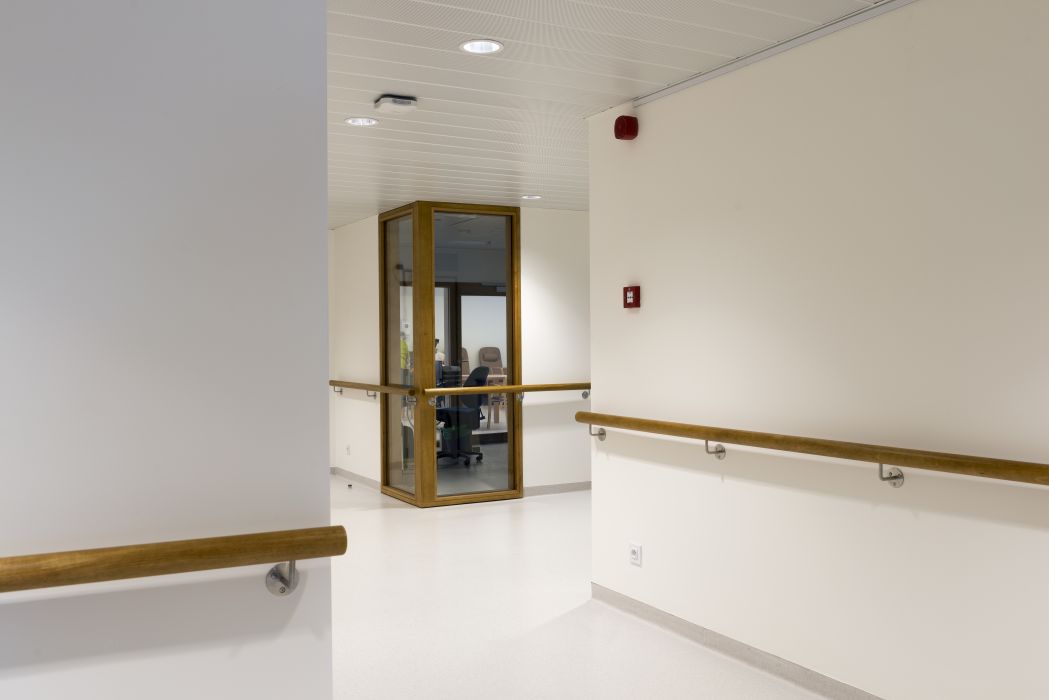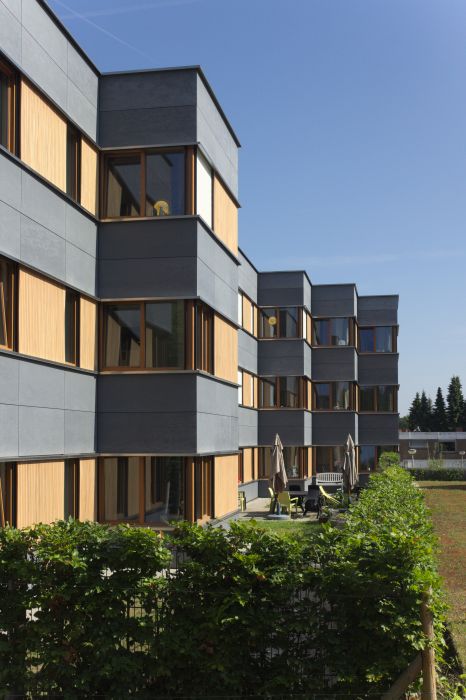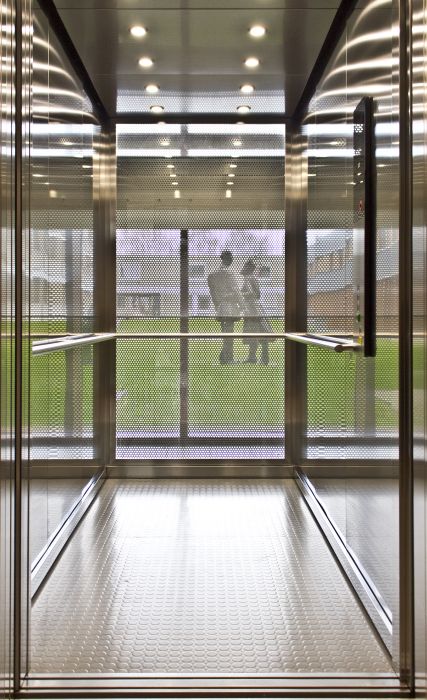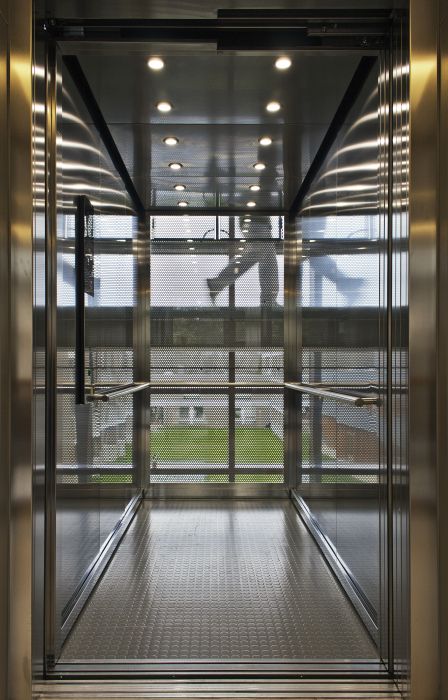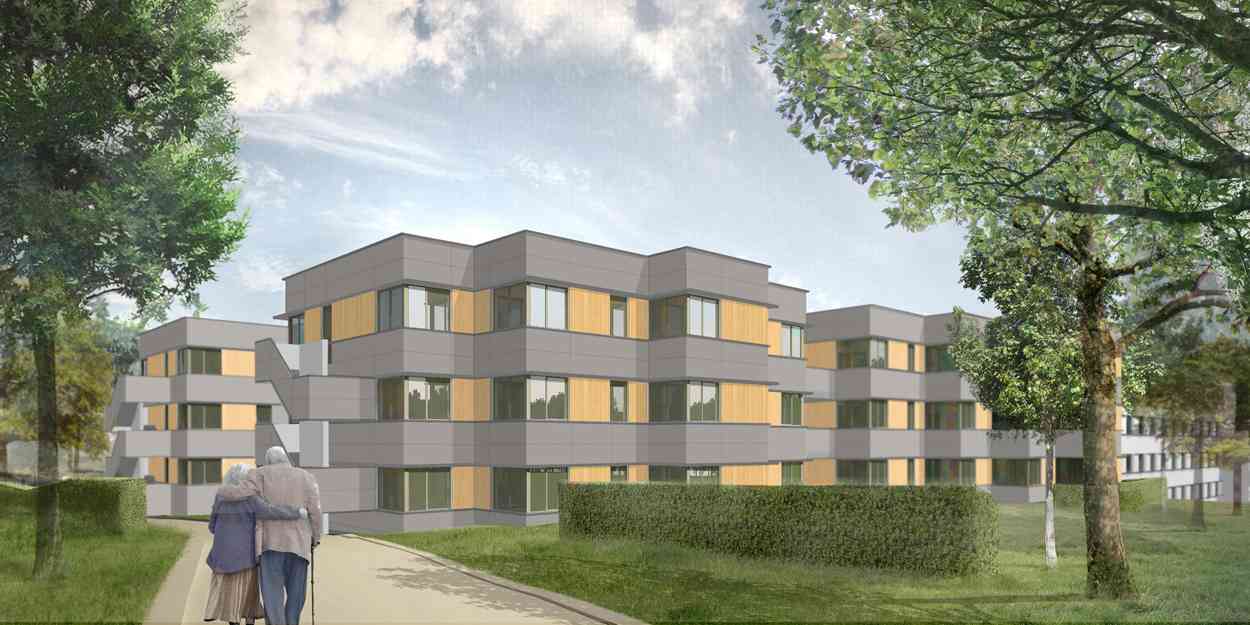© Photo: Robin LEJEUNE

527 – RUSTOORD TE SINT-GENESIUS-RODE
Sint-Genesius-Rode, België.
50°44’35,14″N/4°20’55,55″O
5.986 m² nieuwbouw + 1.200 m² zware renovatie/uitbreiding; 2007 – 2016 (01/527).
- Aanleg van de omgeving
- Architectuur
- Interieur architectuur
- Bijzondere technieken
- Budgetbeheersing
Het nieuwbouwproject rustoord voor het OCMW van Sint-Genesius-Rode, de Groene Linde, biedt een nieuwe thuis aan 84 residenten, die zorgbehoevend of dementerend zijn.
Het rusthuis past discreet tussen de bestaande gebouwen en functies van de campus en sluit aan op het bestaande rusthuis dat verbouwd wordt tot zorgflats.
De ruimtelijke spreiding van gebouwen over de site roept het dorpsgevoel op, zodat bewoners kunnen rondwandelen in hun ‘dorp’. Het getrapte grondplan draagt eveneens bij tot het ambiëren van dit dorpsgevoel.
Het gebouw plant zich zacht in op de site, doordat het natuurlijke reliëf wordt gevolgd. Bijgevolg hoeft slechts een minimale hoeveelheid aan aarde afgegraven te worden.
De bestaande en nieuwe gebouwen organiseren zich rondom een ‘kasteeltuin’ met een bomenrij en hagen op verschillende niveaus.
De onthaalzone wordt met grote zorg behandeld. Het is namelijk de ontmoetingsplaats bij uitstek voor residenten. Ze installeren er zich overdag om een praatje te slaan en te observeren wie het rusthuis binnenkomt en verlaat. De inkomzone wordt geanimeerd door de gelijkvloerse commerciële ruimtes en administratieve diensten die erop uitgeven.
De vorm van het gebouw is zo opgevat dat de afdelingen verwisselbaar zijn. Hiermee wordt een maximale flexibiliteit nagestreefd, zowel op korte als op lange termijn.
Een leefgroep bestaat uit 14 residenten waarin het dagelijkse gezinsleven zoveel mogelijk wordt benaderd. Daarom beschikt elke leefgroep over een ruime woon- en leefruimte en keuken, waar gezamenlijke activiteiten zoals koken, televisiekijken, … plaatsvinden. De verpleegkundigen kunnen de residenten observeren vanuit hun centrale verpleegpost en de bewoners voelen zich gerust.
In het kader van genormaliseerd wonen beschikken 2 leefgroepen over hun eigen private toegang en een afsluitbare tuin of een privaat terras.
Het rusthuis is ontworpen als een unieke, persoonlijke plek die niet refereert naar een ziekenhuis met lange, doodse gangen, omdat deze nefast zijn op het vlak van leefbaarheid en perceptie. Daarom wordt de lengte van de gangen beperkt en wordt hun perspectief gebroken. Alsook wordt de lengte van de galerijen beperkt door de kamers van iedere leefgroep onder te verdelen in 2 subeenheden. Bovendien worden dode uiteinden vermeden: aan elk uiterste van een galerij bevindt zich een doel, zoals een intiemer salon of kleine kinéruimte.
Ieder individu heeft de keuze om deel te nemen aan het leven in de gemeenschappelijke ruimtes, dan wel zich terug te trekken op zijn kamer. Daarom zijn de bewonerskamers voldoende ruim. Ze beschikken allen over een hoekvenster. Zo genieten de residenten van een mooier uitzicht en een optimale lichtinval.
Tussen het slaap- en sanitair gedeelte van de kamer wordt een wegneembare wand voorzien. Dit laat het verzorgend personeel toe zwaar zorgbehoevende bewoners op eenvoudige wijze naar hun sanitaire cel te begeleiden.
Alle ruimtes worden zoveel mogelijke met daglicht bediend. Bijvoorbeeld de liftschacht in geperforeerde platen laat het licht binnen gloeien en laat een zicht naar de binnentuin toe.
Op het vlak van duurzaamheid is het gebouw luchtdicht en zeer geïsoleerd ontworpen. Het regenwater wordt binnen watertanks met een capaciteit van 93 m³ gerecupereerd en voedt de sanitaire toestellen en een adiabatische koeling.
De gevel is bekleed met grijs gekleurd vezelcement platen en blond-houten lamellen. Deze zijn beschermd door continu roestvaste waterlijsten.
Na de voltooiing van het nieuw rusthuis werd beslist om de bestaande behouden vleugel, die 27 residenten herbergt, in dezelfde geest volledig te renoveren.
“The decor of the facades features a colourful patchwork. The colours are arranged to form an orthogonal grid made of monochrome surfaces in adjacent juxtaposition, in accordance with the architect’s plans and arranged by the painter according to a complex evolution algorithm which determines the succession of the colours in both axes. Repetitions of the same colour in one axis create vertical or lateral movement; repetitions in both axes form determining points. These localised clusters break the regularity of the grid.
The whole represents the continuation of an original composition composed of 420 x 34 units. It is a combination structured with sets of local symmetries which have been intricately researched. The variations of colour, saturation and/or intensity create two opposite effects, concurrently and successively: the colours are either associated harmoniously, or dissociated by contrasts. The results are resonances, transparencies, continuity and rupture which at times drive and at other times temper the substance of the composition.
Consequently, this flat surface features a singular spatial quality. It is a modulating space where what at first appears as a shape on a background suddenly transforms into a background from which shapes detach depending on localised perceptions, associations or experiences which are impossible to predict in their totality. The permutations or transmutations in the perception of space are always localised and temporary, constant and unpredictable.
This unique spatial interplay is crafted and calibrated. In its progression around the buildings, the decor creates a polychromatic effect marked by the mutation in phases of the dominant colours. This mutation underlines the “butterfly-shaped” design of the new building and the progression and regression contract the succession of colours – the perception of the phases is all the more accelerated. The facades that give on to the exterior offer the detachment of a view of the whole. The semi-open spaces between the different aspects of the building create micro-phases where the chromatic features are concordant with the distance at which they are viewed.
The decor continues its progression of co-existence on the facades of the renovated old buildings which contributes to the integration of the new constructions by way of more protracted successions, accelerated by a reduction in the width of the coloured surfaces. An interior garden planted with trees offers the residents views on all sides.
The decor will contribute to making the home (an imposing building due to its size) more human, due to its general aspect as well as due to a succession of aspects experienced from a personal or individual point of view. This decor has been conceived to give the effect of diverse subsets cut out by the positioning of the construction as well to provide all the differentiated compositions that stem from the variety of perspectives that can be obtained from the inside of the buildings. The residents will be able to see these familiar compositions from the windows creating reference points within the building. But this decor will remain an aesthetic enigma. No one will have the impression of knowing it as a result of the myriad interactions that occur between the colours, contrasts and affinities, determined by the variations of the morning and evening light and depending on the season.
To whom would be surprised by the chromatic audacity of the project it must be pled that this is a spectacle in harmony with the entorno, covered with lawns and planted with trees. The order, the rhythm and the architectural regularity of the building are sufficient to firmly frame this decor and to channel the chromatic flux. Would we prefer for these regularities to span lifeless surfaces with institutional neutrality and large toneless or monochrome surfaces? The home is for housing the elderly. It is better if the exterior decor of their buildings invokes sensations – it is said that this kind of activity contributes to delaying or inhibiting degenerative affections of the nervous system which are nowadays rife in our population. Residents who will take interest in this decor will live longer – they will live less or less well in an inert decor.”
Georges Meurant, 2011-12-12.
© Photos: Marie-Françoise PLISSART
© Photos: Quentin OLBRECHTS
© Photos: Robin LEJEUNE
Maître de l’ouvrage
BELFIUS BANQUE & ASSURANCES
Avenue Pacheco, 44, RT 30/04, B-1000 Bruxelles
tél: +32 2 222 39 33 fax: +32 2 222 33 68
Monsieur Frank DE RAES, Senior Projectmanager Real Estate, Project Management & Support
frankie.deraes@belfius.be
UTILISATEUR
CPAS de Rhode-Saint-Genèse
Rue du Village, 74, 1640 Rhode-Saint-Genèse
tél: +32 2 380 55 55 fax : +32 2 380 55 65
Xavier Deleenheer, président du CPAS; Steve Waeyaert, secrétaire du CPAS; Els Wets, directrice de la maison de repos
ARCHITECTES & INGÉNIEURS
Philippe SAMYN and PARTNERS sprl, architects & engineers Philippe Samyn
Chaussée de Waterloo, 1537 B-1180 BRUXELLES Propriétaire exclusif des droits d’auteur (copyright)
Tél. + 32 2 374 90 60 Fax + 32 2 374 75 50
E-mail: sai@samynandpartners.com
ÉQUIPE
Architecture et ingénierie
Conception et Direction : Philippe SAMYN.
Associé(s) en charge : Jacques CEYSSENS, Liesbeth GESTELS.
Collaborateurs : Naomi L’ABBATE, Dimitri DEBOUGNOUX, Sarah DEHASQUE, Nathan DUVIVIER, Dikran GUNDES, Nacer HOSNA, Jessica LANGE, Danielle MULLANE, Joris NIVELLE, Paolo RUARO, Gunhi Boar SILVA BATICAM, Pawel SIERADZON, Matthijs STOFFELS, Chloé STUEREBAUT, Bart SUETER, Benjamin VANCAUDENBERG, Christophe VAN RAEMDONCK, Jean-Michel VAN DE PUTTE, Monika WIELOCHA.
Techniques spéciales : Philippe SAMYN and PARTNERS sprl, architects & engineers,
avec FLOW TRANSFER INTERNATIONAL sa (sous-traitant)
Andrew JANSSENS, Gaël BERNARD, Frédéric MICHAUX.
Rue du Ham, 137, 1180 Bruxelles, Belgique
Tel. : +32 2 375 75 40
E-mail : info@fti-sa.be
Stabilité : Philippe SAMYN and PARTNERS sprl, architects & engineers,
avec INGENIEURSBUREAU MEIJER bvba (sous-traitant)
Jan MEIJER, Antoine CAMBIER, Adrien JACQUEY, Thomas PERARNAU, Ben VERBEECK.
Prins Boudewijnlaan, 53/2, 2650 Edegem, Belgique
Tel. : +32 3 448 25 00
E-mail : info@meijer.be
en contrat direct avec le Maitre d’ouvrage :
Coordination sécurité/santé : VEKMO nv
Watermolenstraat, 41, B-3140 Keerbergen, Belgique
Tel. : 016/22 89 58
E-mail : info@vekmo.be
DOCUMENTATION
Gestion documentation : Philippe SAMYN and PARTNERS (André CHARON et Quentin OLBRECHTS)
Images de synthèse : Polygon Graphics (Stijn STRAGIER)
Proposition d’intégration
picturale : Georges MEURANT
Photographie : Marie-Françoise PLISSART
ÉXÉCUTION
Entreprise pilote : STRABAG nv
Gros-œuvre et finitions Apostelhuizen, 26, B-9000 Gent.
Installations sanitaires : Van Hoey bvba
Jubellaan, 153, B-2800 Mechelen
Installations HVAC : Celcio bvba
Watlingtonstraat 1, 9000 Gent
Installations électriques : Cofely Fabricom nv
Gatti de Gamondstraat 254, B-1180 Brussel
Installations ascenseurs : KONE Belgium & Luxembourg nv
Bretagnestraat, 24, B-1200 Brussel
Abords : Estate and Landscape Management bvba
Vroonbaan, 53 – B-1880 Nieuwenrode
Mobilier fixe : Lohisse nv
Dendermondsesteenweg 177 – 1730 Asse
Rideaux : Top Floor nv
Lodderstraat, 18, 2880 Bornem
Cuisine centrale : Bossuyt Grootkeuken nv
Noordlaan, 19, 8520 Kuurne
Signalisation : Studiegroep LABYRINT bvba
Zone 5 Mollem, 270, B-1730 Asse
Escaliers et terrasses en acier : METALPROJECTS Overpelt nv
Europalaan 39, B-3900 Overpelt
Dhr Davy Winter
For plans sections and elevations, please refer to the archives section of the site available from the “references” menu.






